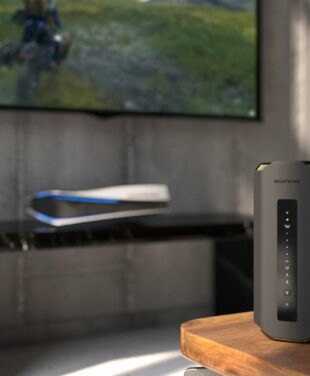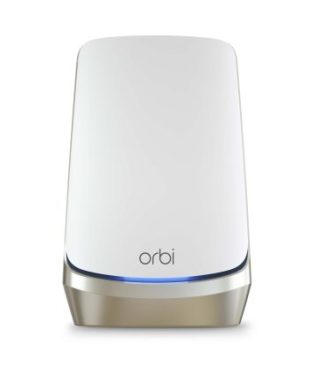When upgrading from a stand-alone WiFi router to a whole-home mesh WiFi system, a question often arises: do I need a modem? The simple answer is yes! A router can’t work by itself, as the router gets its signal from a modem which receives data from your internet service provider (ISP). Read on to get a better understanding of modems, routers, and WiFi mesh for your next WiFi upgrade.
IN THIS ARTICLE
- Understanding Mesh WiFi Systems
- The Essential Role of a Modem
- Mesh WiFi and Modem: A Symbiotic Relationship
- Choosing the Right Modem for Mesh WiFi
- Integration of your Modem with Mesh WiFi Systems
- Traditional WiFi vs Mesh Networks
- Orbi Entertainment, Gaming, and Smart Homes
- Orbi 970 In a Nutshell
- FAQs
Understanding Mesh WiFi Systems
Mesh WiFi is a huge leap forward that delivers seamless internet coverage for home networks, guest networks, and smart home applications. Unlike traditional routers which are prone to struggle with WiFi dead zones, a mesh system uses multiple satellite nodes to broadcast the wireless signal throughout every corner of the home or office. Mesh WiFi networks are particularly useful if you have a large home or complex layout with lots of connected devices.
WiFi mesh networks include a main access point router connected to a modem, which is connected to the internet. You can also use a combination router/modem. The WiFi signal is then broadcast to multiple mesh WiFi satellite nodes placed strategically for the best possible internet connection upstairs, downstairs, and even outdoors. Mesh WiFi delivers blanket coverage to avoid latency, lag, and connection dropouts.
The satellite nodes communicate with an overlapping WiFi signal to form a single cohesive network. Your devices automatically connect to the strongest node signal, ensuring a seamless online experience. WiFi 7 mesh systems, such as NETGEAR Orbi 970, are a game-changer for video streaming, conferencing, multi-player gaming, medical, educational, and industrial applications, virtual reality, and the Metaverse. It’s an exciting time to upgrade to mesh WiFi.
The Essential Role of a Modem
Before we get too far ahead of ourselves, let’s not forget about the humble modem. This little box is the gateway between your ISP and the online world. A modem translates signals into a language your connected devices understand. While a stand-alone router or router mesh system broadcasts the WiFi signal, it is the modem that brings the internet to your doorstep.
Modems don’t get the accolades of their router relatives, but they are still an essential network component. Apart from the ISP connection, modems can also correct data errors and control the data flow sent to and from your network. Your modem will know if the information sent by your ISP doesn’t match the values assigned to your devices. A modem can tell your connected devices when to transfer data, how much data to transfer, and control data transfer speeds.
Mesh WiFi and Modem: A Symbiotic Relationship
Think of your modem and mesh WiFi system as a dynamic duo. The modem hooks you up to the internet, and the mesh system spreads that connection far and wide. Without a modem, your fancy mesh system is like a sports car without fuel – it looks great but isn’t going anywhere. Whether you use WiFi 5, WiFi 6, WiFi 6E, or the latest and best WiFi 7, a modem and main router are both essential for your wireless connection.
There are several types of modems used in Australia and around the world. These include analog, Integrated Services Digital Network (ISDN), digital subscriber line (DSL), cable, and fiber optic. Analog, ISDN, and DSL models all use telephone lines, while cable modems use a coaxial cable. Fibre optic modems use microscopically thin glass or plastic strands.
Analog and ISDN
Analog modems can only use a single data stream. With these last-century systems, you can’t use the internet and talk on a home phone at the same time. Analog modems are very slow and can only reach speeds up to 56 Kbps. To improve outcomes, ISDN was developed to carry up to three data streams at the same time, with speeds up to 128 Kbps. These two dial-up connection types are rarely used today.
DSL
DSL modems also use phone lines to transmit data, but they work on a different frequency. With DSL, you can make calls on your home phone while simultaneously using the internet. DSL can theoretically deliver speeds up to 100 Mbps, although these speeds are usually unachievable and are also impacted by the distance to your ISP’s nearest station.
Cable
Cable modems are faster and more reliable than DSL. and they aren’t impacted by how far you are from your ISP. However, your connection will slow down when there are lots of people in your area using the internet at the same time. Cable can theoretically support speeds up to 1 Gbps.
Fibre Optic
Instead of using electrical signals to transfer data, as with DSL and cable, Fibre Optic uses light pulses. With Fibre Optic, the connection isn’t impacted by distance from your ISP or by the number of people using the internet simultaneously in your area. In today’s superfast internet marketplace, it’s not uncommon to find NBN internet plans offering gigabit speeds from 1 Gbps to 10 Gbps.
You will still need both a modem and a router if you want to use WiFi or connect multiple devices. Many modems have only one LAN Ethernet port, and a modem won’t provide the same NBN security that a router does.
Choosing the Right Modem for Mesh WiFi
Picking the right modem for your mesh system is crucial. You’ll want something that matches your ISP’s specs and can handle your internet plan’s speed. After all, there’s no point in having a super-fast mesh system if your modem is like a snail on a treadmill. Then you will need to consider your router.
A router allows multiple devices to communicate with each other over a network. Most routers can accommodate multiple wired Ethernet connections and also wireless connections via WiFi. A WiFi router connected to a modem can send data through radio signals to provide WiFi access to multiple devices in concurrent use.
Many ISPs provide customers with a modem and a router or a modem/router combo device. However, you can usually purchase a different modem and router separately. Using your own devices can give you more features and superior performance, while also saving on monthly ISP modem and router rental fees.
Plus, you can replace your router as technology improves. Modem technology doesn’t change as quickly as router technology, so upgrading one device at a time is cost-effective.
Integration of your Modem with Mesh WiFi Systems
Setting up your modem with a mesh system is a breeze. Connect the primary router to your modem and you are good to go. Simply place the additional satellite nodes strategically around your home for the best possible WiFi connection and maximum square feet coverage. NETGEAR Orbi systems are easy to set up and offer compatibility with a wide range of modems on the market today. Designed for ease of use with everyday Australians in mind, NETGEAR
Orbi is changing the way we network in homes, offices, and other establishments around the country.
For those who love to stay ahead of the curve, consider looking into advanced mesh WiFi modem features like DOCSIS 3.1 for faster cable internet. And if you’re into simplifying your setup, a modem-router combo might just be your cup of tea. Just ensure it can integrate with your whole-home WiFi mesh system.
Traditional WiFi vs Mesh Networks
Most traditional routers and modems in Australia use Ethernet cables for establishing connections. In some cases, a combination gateway modem/router is used. Mesh WiFi routers are a newer innovation, with the potential to provide WiFi connections for large multi-story homes and offices. Traditional stand-alone broadband routers are suitable in smaller homes and apartments with fewer devices and fewer device users. Whole-home Mesh WiFi systems are the right choice for large homes and busy households with multiple connected devices. Here are some significant mesh WiFi advantages.
Mesh Network Internet Coverage
Whether yours is dual-band, tri-band, or quad-band WiFi, a mesh network will deliver the best available internet connections and speeds. Wireless mesh network satellite nodes communicate with each other to relay the wireless signal, allowing everyone under one roof to enjoy blazing-fast internet speeds. Delays are minimised and data will take the fastest path to reach your devices.
With traditional router and modem setups, the signal travels the full distance from the router to your device. This can create weak signals or dead zones, particularly if the signal has to travel through solid objects such as walls or doors. In smaller homes, a WiFi range extender can be enough to overcome weak WiFi signals. For larger homes and offices, NETGEAR Orbi 970 WiFi 7 systems are the way forward.
Superfast Mesh Network Speeds
For internet speeds over shorter distances to service a few devices, a traditional router with wired Ethernet connections can still outpace most wireless connections. However, today’s large homes have 20+ connected devices and smart home applications, so there is more to consider when connecting multiple devices simultaneously. It’s not generally feasible to have Ethernet cables running through ceilings, under floors, or in wall cavities to connect to every device.
Even the best stand-alone routers and modems can reach only so far before you begin to suffer from latency and lag issues. In addition, a sole router can’t handle lots of concurrent transmissions and devices will have to wait their turn to connect. In today’s fast-moving world, slow internet speeds are unacceptable. Mesh WiFi solves these issues by delivering a seamless blanket of superfast wireless connection coverage throughout the entire premises.
Mesh Network Performance
Whereas traditional routers can get overwhelmed in high-demand scenarios, mesh networks intelligently manage home networks, guest networks, and smart home Internet of Things (IoT) applications. Signal issues are easily addressed with mesh router nodes and you can reposition the nodes to adapt to changing household or office dynamics. The best WiFi mesh routers operating with WiFi 6, WiFi 6E, and the latest WiFi 7 standard offer internet access like never before. NETGEAR Orbi can change the way you live for the better.
Mesh Network Scalability
Expanding coverage with traditional WiFi can be cumbersome. While range extenders can help, WiFi mesh is now the preferred option for creating expansive local area networks. Mesh networks simplify expansion by using synchronised satellite nodes to dramatically extend coverage. WiFi mesh systems deliver better network scalability and consistent wireless networking performance. For most internet users in Australia, a multi-node mesh WiFi system will deliver unbeatable wall-to-wall WiFi coverage.
Ease of Management
Mesh networks are easy to set up, manage, and optimise. The NETGEAR Orbi app offers remote management via your Apple or Android smartphone. Orbi 970 also includes encrypted WPA3 security and smart parental controls to ensure everyone in your local area network (LAN) or wide area network (WAN) is protected from spam and malicious intruders at all times.
Orbi Entertainment, Gaming, and Smart Homes
NETGEAR Orbi products are designed for easy setup in homes and offices of all sizes. From WiFi 6 mesh systems, WiFi 6E systems, and WiFi 7 systems, there is bound to be a mesh product that’s perfect for you. The best Orbi tri-band WiFi and quad-band WiFi systems use the 2.4GHz, 5GHz, and 6GHz bandwidths to deliver the best possible internet user experience.
NETGEAR Orbi 970 systems are user-friendly, and you don’t need to be a tech whiz to take advantage of the fastest available WiFi 7 speeds. Here are some ways Orbi 970 WiFi 7 can dramatically improve WiFi performance.
Orbi 970 entertainment: Orbi WiFi 7 opens up a whole new world of home entertainment. You can now stream 4K and 8K high-definition content without frustrating slowdowns. Advanced WiFi 7 entertainment applications include virtual reality, augmented reality, animation, and the Metaverse.
Orbi 970 gaming: WiFi 7 dramatically improves online gaming and gives you a winning advantage over the competition. With Orbi WiFi 7, games can be rendered in a fraction of the time compared to earlier WiFi 5 and WiFi 6 routers. Users can enjoy competitive gaming console performance with real-time responsiveness.
Orbi 970 for smart homes:
WiFi 7 is ideal for smart homes. Orbi WiFi 7 offers more bandwidth and faster speeds for handling multiple devices concurrently. Applications include home security systems, smart TVs, Amazon Alexa smart speakers, Google Assistant, Google Home, Zigbee, and more. Available in classic black or classy white, Orbi 970 WiFi mesh systems are attractive decor units that will future-proof your entire smart home network.
Orbi 970 In a Nutshell
NETGEAR Orbi 970 is a quantum leap in WiFi networking. You also have the option to include NETGEAR Pro Support with 24/7 priority access, plus accidental damage coverage and replacement. Plus, Orbi 970 systems are compatible with any internet service provider. Here are some more significant Orbi 970 system advantages in a nutshell.
✔ Blazing-fast speeds of up to 27Gbps for unparalleled square feet of WiFi coverage and unbeatable performance.
✔ 2.4x faster speeds than WiFi 6 and fully backward compatible with older WiFi-enabled laptops and desktop Windows computers.
✔ 4K/8K streaming, video conferencing, HD gaming, virtual reality, the Metaverse, and a wide range of technical and industrial applications.
✔ Quad-band technology and dedicated backhaul for delivering reliable WiFi across your entire wireless network.
✔ Elegant Orbi node design and high-performance antennas for 360° WiFi coverage to reach all your connected devices.
✔ The fastest available internet speeds with built-in Orbi router 10 Gbps and 2.5 Gbps Ethernet ports.
✔ Seamless roaming with a system that always detects the strongest available signal to ensure a fast and stable connection.
✔ The ability to sync NETGEAR Orbi 970 WiFi 7 with any internet service provider (ISP), plus easy setup and management of your Orbi 970 WiFi network using the Orbi app.
✔ NETGEAR Armor encrypted WPA3 security software for protection against malicious intruders across all your connected devices and applications.
FAQs
Can I use my existing modem with a mesh WiFi system?
Absolutely! Just make sure it’s up to speed with your current internet plan and compatible with your mesh system.
How do I know if my modem is compatible with a mesh network?
Check with your ISP, your product manufacturer, and your buying guide. If in doubt, contact your local NETGEAR retailer for more advice and inspiration.
Is it better to have a separate modem and router?
It depends on your needs. Separate devices offer more flexibility, but a combo unit is a neat, all-in-one solution for basic networks.
Can mesh WiFi systems improve internet speed without a new modem?
They can improve coverage and stability, but your speed is ultimately capped by your modem and internet plan. You can always change ISP and purchase a new mesh WiFi modem to suit your specific needs.




